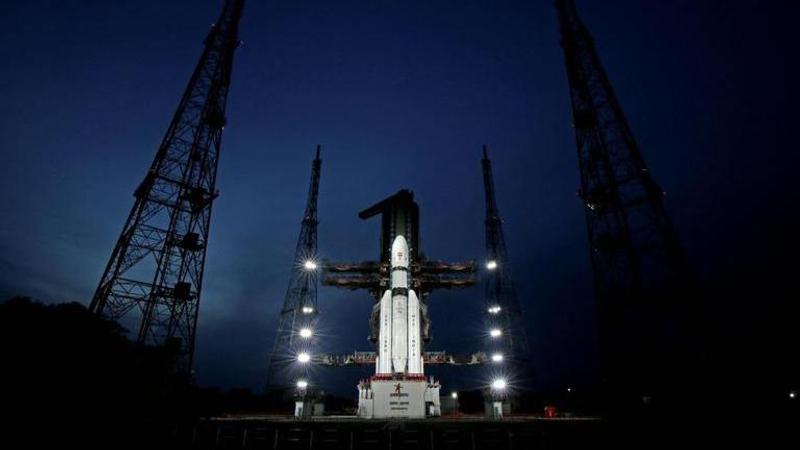Published 17:52 IST, July 11th 2023
Chandrayaan 3 completes launch rehearsal, ISRO confident of moon mission
ISRO announced that it simulated all the procedures for the Chandrayaan 3 mission and the process lasted a full 24 hours.

Advertisement
Indian Space Research Organisation has successfully completed the launch rehearsal ahead of the highly anticipated Chandrayaan 3 takeoff on July 14. Making the announcement, the Indian Space Research Organisation (ISRO) confirmed the Chandrayaan 3 mission team simulated all the procedures just like it will on the launch day and the process lasted a full 24 hours.
"The ‘Launch Rehearsal’ simulating the entire launch preparation and process lasting 24 hours has been concluded," ISRO tweeted.
Chandrayaan-3 mission:
— ISRO (@isro) July 11, 2023
The ‘Launch Rehearsal’ simulating the entire launch preparation and process lasting 24 hours has been concluded.
Mission brochure: https://t.co/cCnH05sPcW pic.twitter.com/oqV1TYux8V
The Chandrayaan-3 mission is scheduled to be launched on July 14, 2023, at 2:35 pm Indian Standard Time (IST) from the Satish Dhawan Space Center in Sriharikota in the Shar Project settlement of Tirupati district in Andhra Pradesh. If all goes well, the spaceship will land on the moon on August 24.
During the launch rehearsal, ISRO teams conducted a countdown with full loading of propellant into the Launch Vehicle Mark-III (LVM3) that will launch the mission to the moon. ISRO has named the rocket LVM3-M4 since it is the fourth mission of this particular launch vehicle.
(The LVM3 rocket at the launch pad in Sriharikota; Image: ISRO)
Standing 43.5 metres tall, the rocket uses three kinds of propellant - solid fuel in the strap-on boosters, liquid fuel in the core stage and cryogenic fuel in the upper stage. According to ISRO, the boosters will be powered by 204.5 tonnes of solid fuel, whereas the core stage and upper stage will carry 115.8 tonnes and 28.6 tonnes of propellant each. Taking the mass of Chandrayaan 3 into consideration, which is 3,900 kilogrammes, the rocket will lift off with a mass of 642 tonnes.
About the Chandrayaan-3 mission
As ISRO Chairman S Somanath told Republic TV, that the primary aim of the Chandrayaan 3 mission is to make a soft landing in the southern lunar polar region. Recalling Chandrayaan 2, which was launched on July 22, 2019, but failed to touch down on the moon, Somanath said that ISRO has learned from its mistake and corrected it. The Chandrayaan 2 was partly successful as ISRO managed to place its orbiter around the moon but failed to land.
ISRO has retained the names of Vikram and Pragyan for its lander and rover, respectively, which will collectively explore the Moon for 14 Earth days or one lunar day. The Lander Module (LM) weighs 1,752 kg and has objectives like measuring the plasma density near the lunar surface, measuring thermal properties near the polar region, investigating seismic activities of the moon and understanding the overall dynamics of the lunar system.
(The Chandrayaan-3 lander integrated with its Propulsion Module; Image: ISRO)
Another important element of Chandrayaan 3 is the Propulsion Module (PM) which will power the lander to a 100 km circular orbit above the lunar surface after it separates from the upper stage of the LVM3 rocket. But these are the later stages of the mission which ISRO will reach after acing several steps where there are many single points of failure.
Firstly, the rocket needs to inject Chandrayaan 3 with extremely high precision into the right orbit (170 X 36,500 km). The spacecraft will then make five orbits of the Earth before ISRO performs the lunar injection manoeuvre to send it toward the Moon. Chandrayaan will then enter an elliptical orbit around the Moon and make five more circles before entering a circular orbit; this will bring it just 100 km above the surface. Here, the PM will separate from the lander which will gradually descend for a soft landing. This module is also equipped with an instrument called the Spectro-polarimetry of Habitable Planet Earth (SHAPE) payload to study the spectral and polari-metric measurements of Earth from lunar orbit.
Talking about the measures taken to avoid Chandrayaan 2-like scenario, Somanath said that the legs of the lander module has been strengthened, more propellant and sensors have been added along with a Lander Horizontal Velocity Camera and a Laser Doppler Velocimeter to measure the lander's speed. Landing on the Moon is the most tricky part of the mission and only three countries-- the US, USSR and China-- have had a successful touchdown. It was the same landing stage where Japan's ispace lost its lander in April 2023.
17:52 IST, July 11th 2023





